Information Flow | LDWA System Project Update
Updated: 01/2023
The purpose of this page is to provide information about current Leeds Domestic Waterusers (LDWA) projects, explain their need and benefits and inform the community about potential impacts during construction. Although the LDWA understands that construction creates an inconvenience, it is committed to keeping the community informed.
[Download Brochure]
Construction Project Updates
As a culinary water provider, we continuously upgrade, maintain, and repair our system so it can continue to serve our customers. The purpose of this page is to provide information about current LDWA projects, explain their need and benefits and inform the community about potential impacts during construction.
Although the LDWA understands that construction creates an inconvenience, it is committed to keeping the community informed of current projects, while working to minimize construction impacts as much as possible.
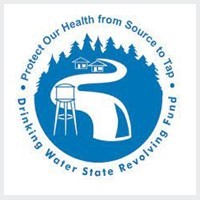 Utah Division of Drinking Water, State Revolving Fund (SRF) Package
Utah Division of Drinking Water, State Revolving Fund (SRF) Package
On August 31, 2022, the Division of Drinking Water (DDW) Board met and authorized a loan of $7,519,500, with $3,499,500 principal forgiveness to LDWA for drilling a new well, installing a chlorinator, installing an altitude control valve and vault, replacing 4,500 feet of water main and transmission line replacement. The loan terms offered to the LDWA are forty (40) years, at an annual Interest Rate of 0%.
An additional $273,000 has since been petitioned to be included in the loan repayable amount to pay off the remaining balance of the 2012 loan. DDW staff will recommend the inclusion at the November 2022 DDW board meeting.
Interest accrual will be at the new 0.0% rate, rather than the previous 3.6% rate, saving LDWA over $45,000.
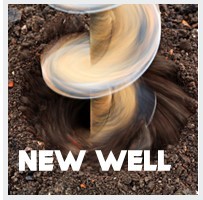 PROJECT 1 OVERVIEW :: New Well
PROJECT 1 OVERVIEW :: New Well
[Preliminary Estimated Cost – $1,316,000]
LDWA currently gets its water from LDWA Spring and Highland Well. The water from the spring is shared with the Leeds Water Company (LWC) irrigation company. LDWA portion amounts averages about 120 gallons per minute. The well can produce approximately 335 gallons per minute. The total average source capacity adds up to 455 gallons per minute.
Over the years the several LDWA boards have wisely commissioned a number of Water Capacity Studies done, by multiple consulting engineers, on the system. In each of the last four studies (2007, 2015, 2017 & 2021), it was identified that the LDWA is deficient in source when using the State of Utah Drinking Water guidelines. It has been recommended that a new well location and well in the amount of 700 gallons per minute be secured, drilled, and developed.
In 2010 a Loan was entered into by the LDWA, and the projects scoped out within it was the drilling of a new well. Unfortunately, after 2 failed attempts to locate a suitable location, this project was terminated.
Currently, in event either of the existing sources is rendered inoperable (by maintenance, emergency, or reduced source generation), neither one is sufficient to supply the current system demand. A redundant source is necessary for the source security of the LDWA shareholders. By having this redundancy, we can simply switch pumping to our second well, or if demand requires, we can pump both wells. An additional concern is related to a Power Grid failure. No power, no pumping. So, another of our goals is to install a 3 phase propane backup generator capable or supplying power to our pumps during such an electrical outage.
The scope of the project includes the testing of the existing well with upsized and improved pump and monitoring equipment. Site proposed well based on performance of existing well test. Design well, pump, and pump controls per DDW public water system criteria. Construction engineering during well drilling. Documentation for DDW well approval. Also included are Well House, Site Improvements, Valving and System Chlorinator. This includes design well pad, site improvements, new well house, chlorinator, and detailed valving for connection to existing system infrastructure. Construction engineering for said design and documentation for DDW well approval.
FOOTNOTES:
“The calculations . . . demonstrate that LDWA does not have sufficient source capacity. . .” (Page 10)
“The projected source capacity surplus or deficit is determined by subtracting the projected required source capacity of 1,203 gpm from the total available source capacity of 512 gpm, which yields a projected deficit of 691 gpm at the end of the 20-year planning period.” (Page 10)
Leeds Domestic Water Users Association Culinary Water Master Plan 2007
by Sunrise Engineering
“LDWA is deficient in source when using the State of Utah Drinking Water guidelines. It is recommended that a well location and well in the amount of 450 to 500 gallons per minute be secured, drilled and developed.” (Page 11)
Leeds Domestic Water Users Association Culinary Water Capacity Analysis 2015
by ProValue Engineering
“LDWA is deficient in source when using the State of Utah Drinking Water guidelines. It is recommended that a well location and well in the amount of 450 to 500 gallons per minute be secured, drilled and developed.” (Page 13)
Leeds Domestic Water Users Association Water Impact Fee Facility Plan & Analysis 2017
by ProValue Engineering
“LDWA is deficient in source when using the State of Utah Drinking Water guidelines. It is recommended that a well location and well in the amount of 450 to 500 gallons per minute be secured, drilled and developed.” (Page 12)
Leeds Domestic Water Users Association Culinary Water Capacity Analysis 2021
by ProValue Engineering
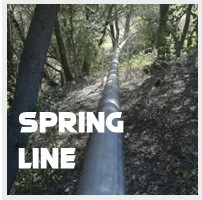 PROJECT 2 OVERVIEW :: Spring Transmission Line Replacement
PROJECT 2 OVERVIEW :: Spring Transmission Line Replacement
[Preliminary Estimated Cost – $2,794,000]
Our Spring capture basin and 4” steel water line was constructed in 1954 at great cost and sacrifice by some amazing pioneers in this area. We owe them a great deal of thanks and admiration for their determination, grit and forward thinking. They sacrificed time, labor and money not just for themselves but for us, the future beneficiaries.
As with all things, age takes its toll and this line has reached its projected useful life. In addition, we were able to increase Oak Grove Spring flow last year by removing some of the trees surrounding Oak Grove Spring. It is projected that removing more of this water intensive vegetation and some modifications below the spring can further increase flow. LDWA water rights from the spring is dependent the total flow of Leeds Creek and the spring, as agricultural land is developed it is expected those agricultural rights will be transferred to allow LDWA to serve those retired lands with culinary water.
Consulting engineers have analyzed the overall conditions of the Oak Grove transmission line as well. Their findings indicate that the 69-year old line is nearing the end of the expected service life, based on the extremely corrosive soils in and around Leeds and the typical service life of steel pipe in surrounding areas. The recent repairs to the lower portion of the spring indicate that failure has started occurring in varying degree. Steel pipe becomes brittle with corrosion and is further vulnerable to landslides and earthquakes. As the primary year-round water source, the engineer determined that the Oak Grove and spring transmission line should be replaced as soon as is feasible.
By replacing the current 4”, 68-year-old water line with a new larger 8” line we assure continued and possibly increased Spring water flow both now and into the future.
The project scope Oak Grove Spring Transmission Pipeline Replacement includes design pipeline and appurtenance replacements for approximately 5 miles of Oak Grove spring source transmission line. Construction engineering for said design and documentation for DDW pipeline approval.
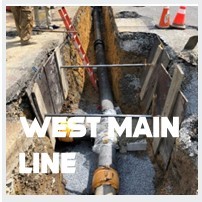 PROJECT 3 OVERVIEW :: Distribution Line Replacement [West]
PROJECT 3 OVERVIEW :: Distribution Line Replacement [West]
[Preliminary Estimated Cost – $1,195,000]
The west side Main Street main water line was installed in 1976 making it 46 years old reaching its useful life for a PVC main water line. Besides being undersized for fire flow by today’s standards, the strength, wall thickness and durability of this pipe is substandard. (Class-C as to superior current C-900 PVC specifications)
This line is the one connected directly to our Fire Hydrant System through the center of Town. The intent is to replace this 6” line with a 10” line to accommodate future water needs at the south end of Leeds and to meet current Fire Hydrant flow requirements for industrial, commercial, municipal and larger structures along Main Street.
Since the Washington County Water Conservancy District, WCWCD, is moving ahead to replace their failed large main water line which passes through Leeds, we have been able to work cooperatively with them to replace our line at the same time thus saving cost on shared engineering, pipe pricing (volume purchasing), trenching, asphalt replacement, and safety signage and routing. This cost savings is significant.
Having the West Side of Main Street torn up once instead of twice will not only lessen cost but reduce the time of inconvenience to the citizens of Leeds.
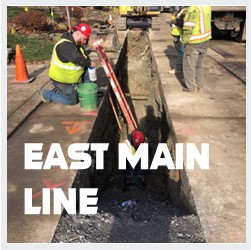 PROJECT 4 OVERVIEW :: Distribution Line Replacement [East]
PROJECT 4 OVERVIEW :: Distribution Line Replacement [East]
[Estimated Cost – $1,210,000]
The Main Street east side water line suffers from some of the same conditions as that of the west side line, however it is somewhat newer and the upper end above Vista Avenue has been replaced with 8” pipe. The plan on this side is to replace the older Class C, 6” water line below Vista Avenue with new 8’ line.
FOOTNOTES:
“Replace waterline on Main Street from Silver Reef Road to the end of the line on the north with 10” waterline. (Will be Needed in the Future)”
Leeds Domestic Water Users Association Culinary Water Master Plan 2007
by Sunrise Engineering
“Replace any 6” bottleneck water lines or dead-end water lines throughout the downtown area with 8” water lines. This includes at least one 8” line along.” (Page 11)
Leeds Domestic Water Users Association Culinary Water Capacity Analysis 2015
by ProValue Engineering
Replace any 6” bottleneck water lines or dead-end water lines throughout the downtown area with 8” water lines. (Page 13)
Leeds Domestic Water Users Association Water Impact Fee Facility Plan & Analysis 2017
by ProValue Engineering
“Replace any 6” bottleneck water lines or dead-end water lines throughout the downtown area with 8” water lines”. “Replace the old existing PRV stations”. (Page 12)
Leeds Domestic Water Users Association Culinary Water Capacity Analysis 2021
by ProValue Engineering
 RATES :: Currently Under Consideration
RATES :: Currently Under Consideration
As mentioned above the DDW committee met on August 31, 2022 and approved our entire $7.5 million package. Their funding package forgiveness of $3.5 million of the total cost and financing the remaining $4 million at 0% interest over 40 years.
While this is obviously a lot of money, the LDWA Board feels the projects and funding are necessary and timely for the following reasons
- LDWA shareholders should be ensured there is adwqaute sources of water now and for the foreseeable future, especially in event of catastrophe or emergency demand.
- LDWA shareholder and Leeds Town should be ensured that current buildings and investments are adequately protected against fire damage.
- The DDW, which is at the forefront of water system projects throughout the State, had reviewed our needs and felt positive enough about the listed projects to support them entirely. DDW also strongly discourages putting off any planned projects in the next 10 years. Any petitions for funding in the 10 years will likely be met with offers of no loan forgiveness and high interest rates.
- The DDW was willing to offer such a generous loan package, including both significant loan forgiveness (47% – $3.5 million) and 0% long term interest.
The proposed projects are both necessary and possible and that the chances of getting such a generous funding package in the future is extremely unlikely.
Therefore, the LDWA Board proposes moving forward with all improvements. The average cost per shareholder will be determined in concert with DDW, who will require an annual loan payment of $107,000. Water rates will be analyzed and reviewed on an ongoing basis.
While this is an increase in the aggregate, as inflation increases the value of the payment decreases relative to the general cost of living. Also, as shareholders are added the cost is spread over a larger base. I Below is some data about our shareholder and their water usage, plus the rate schedule under consideration by the Board.
 |
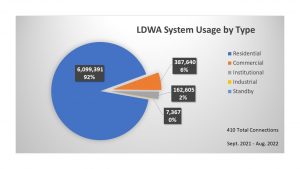 |
|
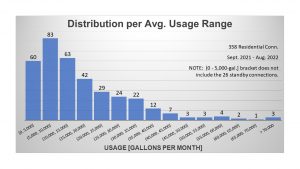 |
 |